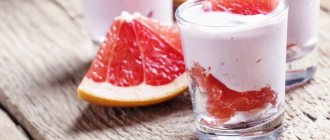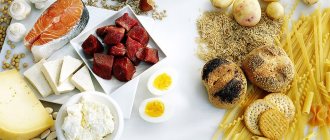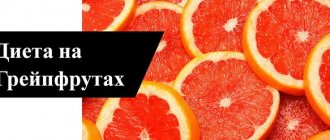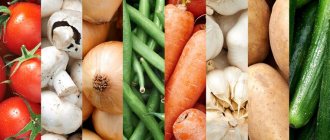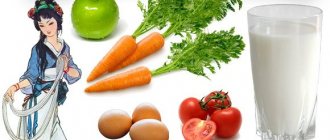- Recipes for vegan days.
Most, when faced with such a concept as veganism, immediately begin to think about hungry days and a meager diet, from which there are no health benefits, and they will be absolutely wrong. Products of plant origin are incredibly tasty and healthy; just learn more about this nutritional system.
So what do vegans eat? In short, these people deny meat, fish and other animal products, from cow's milk to natural honey. Of course, compared to “meat” diets and trends, such a diet and list of products will probably seem boring and very limited, but this is far from the case. In this article you will learn about all the intricacies of creating a vegan menu and what foods you can eat with it.
The essence of a vegan menu
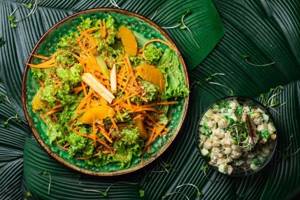
Veganism is a strict form of vegetarianism. Followers of both directions eat exclusively plant foods, but there are some differences between them. If vegetarians do not eat fish, meat, and do not deny themselves dairy products, eggs, and natural honey, then vegans completely abandon animal products.
This limitation of the vegan trend is reinforced by the philosophy of the direction. The main principle is the exclusion from the diet of everything that is associated with suffering and exploitation of animals. It must be said that vegans not only do not eat this food, but also do not wear clothes made of genuine leather or fur.
A vegan diet is based on cereals, legumes, vegetables/fruits and nuts, and mushrooms. People follow his principles if they want not only to lose weight, but also to improve their body health. This trend has enormous benefits, but avoiding animal products entails a health hazard, as there is a lack of many useful substances, macro- and microelements. Before switching to it, you need to consult a specialist.
Menu for the month
Every day for a month, you create your own menu, choosing a diet for breakfast, lunch and dinner from the proposed options.
Morning (breakfast):
- coffee, a couple of toasts, berries;
- milk with bun (bran);
- 2 slices of rye bread, citrus of your choice, freshly squeezed juice;
- toast, tea/coffee, fresh carrots or carrot casserole, banana or apple;
- cottage cheese/curd casserole, natural yogurt, orange;
- oatmeal, tea;
- grain bread, fruit, pineapple juice.
Dinner:
- stewed beans, asparagus, tea;
- rice casserole with broccoli, salad (cucumber, tomato, pepper, carrot, olives), dressed with butter or sour cream, citrus;
- rice porridge, stewed vegetables, pear;
- baked potatoes with vegetables, salad, juice, apple/pear;
- vegetable salad with 2 slices of bread;
- carrot cutlet, rice, citrus of your choice;
- green bean casserole, carrots with cabbage, fruit;
- boiled buckwheat, vegetable sauce, fruit.
Dinner:
- cottage cheese, tomato juice;
- vegetable pate sandwich, banana, compote;
- kefir, egg, pear;
- pilaf with berries, fruits and dried fruits, tea;
- oatmeal, omelet with seaweed, tea;
- buckwheat with mushrooms;
- baked potatoes with asparagus, mushrooms, tomatoes and zucchini.
If you are very hungry on a vegetarian diet, then snacks are allowed, for example, you can eat some fruit or drink a glass of kefir.
A menu that requires a strict vegetarian diet does not include all the substances necessary for the body, so the condition of hair, nails, and skin may worsen, and fatigue and weakness may occur. In such cases, it is advisable to take vitamin complexes or choose a more gentle option for losing weight, for example, a dairy-vegetarian diet.
Vegan food

Veganism involves strictly avoiding the consumption of animal products. And this applies not only to meat, fish, but also to many other items. The “allowed” food list is as follows:
- Fruits/vegetables, berries. This is the basis of the modern vegan diet. Let’s add a variety of greens to the fruit and vegetable component and a complete, balanced diet for the whole day is ready. There is no need to invent anything. You can eat them both raw and thermally processed. There are no specific dishes based on these products. Fantasy is not limited by anything.
- Cereals. Vegans can eat absolutely any grain. Buckwheat is especially valued and can be eaten both boiled and sprouted. They also don’t forget about oats, wheat, amaranth, couscous, etc. All types of cereals are nutritious and healthy.
- Dried fruits. This is a must-have component of a vegan menu. Dried apricots, apricots, prunes, dates, figs, apples - all this and much more can be eaten, both independently and as additives to porridge and many other dishes.
- Nuts/seeds. We can talk endlessly about the benefits and unique composition of nuts, grains and seeds. You will not find such a quantity of nutrients and amino acids in any other product. Modern manufacturers constantly delight followers of proper nutrition with original products based on nuts, seeds and grains. For example, stores offer a huge selection of cereals and muesli bars.
- Soy. This is another essential component of a vegan diet. Soy meat and milk greatly diversify the diet and make the absence of animal products on the menu almost invisible.
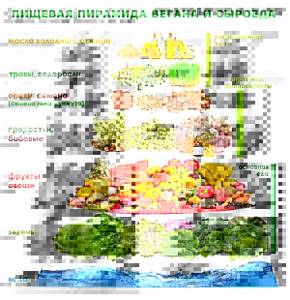
Of course, the list of restrictions on the foods consumed is very long, but what we have is enough to always come up with something tasty and unusual for yourself and your family.
The dangers of veganism
A vegan diet is ideal for losing weight and cleansing the body. But long-term refusal of food of animal origin negatively affects the functioning of many systems and internal organs. Clinical studies have shown that avid vegans often develop serious diseases.
Vegan diet - consequences:
- when there is a deficiency of animal products in the diet, caries develops;
- lack of animal proteins negatively affects the functioning of the liver and thyroid gland;
- Vegan men often experience infertility due to low sperm motility;
- in women, the menstrual cycle is disrupted, the functioning of the endocrine system is disrupted due to refusal of animal fats;
- without stimulation of the stomach with protein foods, digestion suffers, the body absorbs less and less nutrients;
- when you are addicted to soy products, the hormonal balance is disrupted, since soy contains a lot of phytoestrogens;
- anemia, chronic fatigue, deterioration of skin and hair are the most common consequences of veganism.
Plant-based products do not contain retinol, they only contain beta-carotene. The conversion of this substance into vitamin A occurs in the liver. And in vegans this organ works poorly. Vitamin A is necessary for the normal functioning of the thyroid gland and eyes, the immune and reproductive systems, it is involved in the synthesis of hormones, and helps fight fatigue.

Fruits and vegetables contain virtually no B vitamins, amino acids, calcium or iron. Vegans need to take special complexes, but often such preparations contain sugar or are packaged in gelatin capsules.
A vegan diet is often used by people who have poor digestive function - slow metabolism, thyroid dysfunction. Including only vegan foods in your diet does not eliminate the disease itself. But it deprives the body of many useful substances.
Principles of a healthy vegan diet

Vegan food is not always good for the body. In order for this course to bring benefits to the body, you must follow several simple principles:
- We carefully monitor the composition of products. Every day a person should receive the full amount of useful nutrients. We make sure that the diet contains all the necessary components: vitamins, minerals, macro- and microelements, essential amino acids. An imbalance can lead to negative consequences.
- Refusal of soybeans grown from GMO seeds. You should not overuse “healthy” soy, as in excess it can cause hormonal imbalances.
- It is best to replace baked goods with yeast with yeast-free products prepared with natural leaven. Consumption of yeast leads to the maintenance and development of putrefactive processes in the gastrointestinal tract.
- Even if there are no plans to switch to a raw food diet, it is still advisable to give up fried foods, which negatively affect the functioning of important organs.
- We reduce the consumption of sweets - they contribute to the formation of harmful microflora in the body.
- We buy products only from trusted places. A person must be completely sure that the products purchased are environmentally friendly and safe for health.
- When transitioning and further following the principles of a vegan diet, it is recommended to periodically perform fasting to cleanse the intestines and the entire gastrointestinal tract.
By following these simple points, you will not only easily switch to a new lifestyle for you, but you will also comfortably stick to it in the future.
Vegan menu for the week
The vegan menu is compiled individually. Despite the limited list, you can create hundreds of different options for all occasions and any taste preferences. We present to your attention an approximate diet (breakfast, lunch, afternoon snack and dinner).
Monday:
- Herbal infusion and toast with avocado paste.
- A small amount of nuts.
- Zucchini soup, brown rice with vegetables and soy asparagus.
- Lobio in tomato sauce.
Tuesday:
- Boiled buckwheat with the addition of pieces of apples and bananas.
- Tomato soup with lentils and cabbage-tomato salad, seasoned with lemon juice and vegetable oil.
- Rye bread with tofu.
- Millet on water with soy texture and vegetable garnish.
Wednesday:
- Steamed oatmeal with raspberries and blackberries, vitamin tea with herbs.
- Green borscht.
- Dried fruits.
- Mushroom risotto and beet salad.
Thursday:
- Banana-berry smoothie.
- Bean casserole with broccoli.
- Fruits to choose from.
- Zucchini gratin with tomatoes.
Friday:
- Barley with apples and coconut milk.
- Rice soup.
- A handful of dried fruits.
- Carrot cutlets and cabbage salad.
Saturday:
- Whole grain toast with vegetables and tofu cheese, green tea.
- Banana oatmeal pancake and fruit smoothie.
- Berry smoothie.
- Vegetable stew with herbs and garlic, a couple of avocado slices.
Sunday:
- Delicate casserole of cottage cheese with raisins.
- Cabbage cutlets and mashed potatoes.
- Banana smoothie.
- Watercress salad with croutons, tomatoes and tofu.
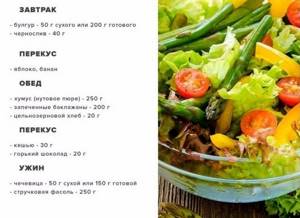
Recipes for Vegan Days
What to add to your weekly menu for variety? Vegan products make it possible to create a varied diet every day, which is unlikely to bore you and will give you a lot of positive feelings. Among the most original and delicious recipes, we offer the following options.
Black rice with vegetables
Compound:
- Black rice cereal - 1 cup.
- Tomatoes.
- Bell pepper - 1 piece.
- Canned peas - 1 can.
- Olives - 4 tablespoons.
- Cold-pressed vegetable oil - to taste, for dressing.
- Arugula leaves.
Cooking:
- Boil the rice in boiling water for about 40 minutes until fully cooked. Next, rinse the cereal under running hot water.
- We clean, chop and add all fresh vegetables to the rice.
- Add the remaining ingredients to the dish.
- Mix everything thoroughly and season with oil.
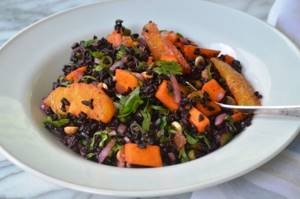
Chickpea hummus
Compound:
- Chickpeas – 450 grams.
- Sesame paste – 4 tablespoons.
- Water – ½ cup.
- Lemon juice – 1-2 teaspoons.
- Paprika – 2 teaspoons.
- Cumin – 1 teaspoon.
- Coriander – 4-5 tablespoons.
- Olive oil.
Cooking:
- Place the boiled chickpeas in a deep bowl and grind with a blender to a paste.
- Add sesame paste to the mixture and mix thoroughly.
- Pour in vegetable oil, a little lemon juice, water and add all the previously prepared spices and herbs.
- Once again we pass everything through the blender until smooth.
- Delicate, aromatic hummus is ready. Bon appetit.
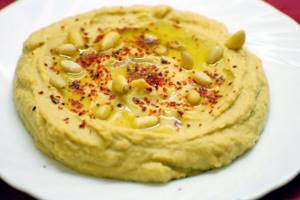
Cake "Bounty"
For the base:
- Peeled almonds - 200 grams.
- Agave syrup – 1-2 tablespoons.
For filling:
- Coconut shavings - 2 cups.
- Agave syrup - 1/3 cup.
- Coconut milk - 5 tablespoons.
For chocolate:
- Coconut milk – 3 tablespoons.
- Carob – 2-3 tablespoons.
- Chicory – 1 tablespoon.
Cooking:
- To prepare the base, pass the almonds through a blender until it becomes flour, add the syrup and mix thoroughly. Place the finished dough into a prepared pan, forming a crust with sides. We level everything thoroughly.
- For the filling, mix all the ingredients and process in a separate bowl with an immersion blender to form a homogeneous mass. Divide the filling into two parts. We lay one of them in an even layer on the prepared base. The second part is mixed with liquid chocolate and placed on top.
- Prepare the chocolate for coating: heat the milk slightly and stir in the chicory and carob. Pour the prepared chocolate mixture over the cake and place it in the refrigerator to soak and infuse.
- Before serving it, you can sprinkle the Bounty with coconut flakes.

Vegetarian diet: Menu for the week
By following a vegetarian diet for 7 days, you can lose from 3 to 6 kg of excess weight. Every day you need to consume from 1200 to 1600 kcal.
- Monday: breakfast – natural yogurt (130 ml), banana, orange, spoon of honey; lunch – soup (450 ml) with whole grain bread; dinner – baked eggplants.
- Tuesday: breakfast – hard-boiled egg, toast, buttered, kefir, ½ grapefruit; lunch – baked potatoes, light vegetable salad; in the evening - beans boiled in soy sauce or sour cream, green salad.
- Wednesday: breakfast – a portion of oatmeal, a glass of milk, an apple, 1 tsp. flax seeds; lunch – vegetable casserole, toast; dinner - vegetable stew.
- Thursday: breakfast - the same as on the first day; lunch - vegetable soup, vegetables stewed in sour cream; dinner – lentils with seasonings, cabbage salad.
- Friday: breakfast - boiled buckwheat, bread, buttered; lunch – borscht, orange; dinner - steamed omelet, vegetable salad.
- Saturday: breakfast – pilaf with dried fruits and nuts; lunch - lentil soup, bread; dinner – vermicelli (hard variety), sprinkled with hard cheese.
- Sunday: repeat the menu of any day.
The benefits of a vegan diet
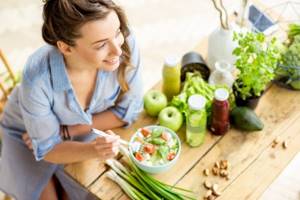
We can talk endlessly about the benefits of food for vegans:
- Positive dynamics in the functioning of the gastrointestinal tract. When switching to a vegan menu, you will quickly feel lightness in your stomach and intestines. It is worth noting that many diseases will go away on their own.
- By giving up animal fats, the body quickly cleanses itself of bad cholesterol. Prevention of many unpleasant heart diseases and atherosclerosis is launched.
- Refusal of animal products means exclusion from the diet of sausages, cheeses, yoghurts, which contain a lot of harmful components, additives and fillers. This reduces the risk of occurrence and development of cancer.
- Antibiotics and hormonal drugs, which are given to animals in excess before slaughter, no longer enter the body.
- Getting the maximum amount of fiber, beneficial nutrients contained in plant-based foods.
- Weight loss, lightness in the body and always a good mood.
Ready-made menu for vegetarians for weight loss - vegetarianism on a diet
Among fans of the now popular healthy lifestyle, there are more and more adherents of the vegetarian diet. Almost every person knows about the benefits of vegetables and fruits.
The fiber contained in plant foods helps normalize the functioning of the gastrointestinal tract. And microelements - potassium and magnesium regulate water metabolism occurring in the body. This is why a vegetarian diet for weight loss is considered optimal. What should the diet be like for vegetarians who support a plant-based diet as a means of losing weight?
Let's look at a sample menu:
- Breakfast: buckwheat pancakes, low-fat yogurt, herbal tea with a teaspoon of honey.
- Second breakfast: rye bread toast, a piece of cheese, natural juice.
- Lunch: vegetable soup with beans, salad mix with cucumber, tomato, tofu cheese, olive oil and lemon juice; uzvar.
- Afternoon snack: a handful of dried fruits with nuts, milk.
- Dinner: stewed cabbage with mushrooms, with olive oil, kefir.
In order to create an optimal menu for weight loss for a week, it is best to seek advice from a specialist.
If a person who decides to lose weight draws up such a menu on his own, he needs to take into account the recommendations of nutritionists:
- Exclude fried, smoked, salty foods from your daily diet.
- To refuse from bad habits.
- Eat small meals.
- Calculate the total calorie content of the finished dish.
- Consume at least two liters of water daily.
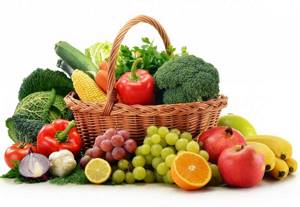
Important! The amount of vegetables consumed per day should be 1-1.5 kg for an adult. It is advisable to eat vegetables and fruits of different colors in your diet, because the more colorful the finished dish is (salad, stew, sauté), the higher the content of useful components in it will be.
Specialist commentary – Sokolovskaya Marina Evgenievna, nutritionist, St. Petersburg:
“In fact, the menu for vegetarians can be very varied. The diet does not end with vegetables and fruits; many people learn to cook familiar foods on their own. For example, now there are many recipes for vegetarian bread, cottage cheese, jelly and other delicious dishes that will complement your diet. A vegetarian menu must include daily consumption of foods with calcium. It is found in cereals, broccoli, dairy products, soy cheese, and figs. If a vegetarian does not have the opportunity to consume eggs and dairy products, it is necessary to take it additionally, this is very important. In this case, eat soy, nuts, beans and vegetables. That is, we can conclude that if you properly balance your diet, find the right replacement for meat products in order to get all the necessary elements for the normal functioning of the body and lead a healthy lifestyle, you can lose excess weight without much difficulty.”
How to switch to a vegan menu
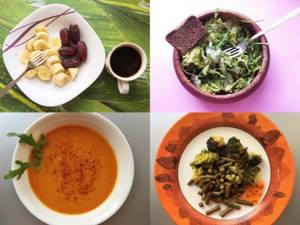
Have you decided to become a vegan? You can’t immediately limit yourself to food. The most important thing is a smooth transition, gradualness. If up to this point you have been a vegetarian, then switching to veganism will not be difficult. If the diet contained meat, dairy products, fish, the transition will take quite a long time. Here are a few points to pay special attention to:
- To begin with, three or four meals a week that contain a meat component should be replaced with plant foods. After a couple of weeks, we will reshuffle a few more meals. Over time, animal products will be completely excluded from the menu.
- Next, remove the fish and eggs. In this case, the main guideline is personal feelings and well-being. If you can give up eggs quickly, then it may take more than one year to completely eliminate seafood.
- We introduce herbal products smoothly, gently, so as not to harm your body and emotional background. A sharp restriction leads not only to quick breakdowns, but also to the fact that veganism will be discredited in the eyes of a person.
Changing eating habits in modern times is very useful. An abundance of harmful foods is a huge stress for the body and the development of many unpleasant diseases. Veganism is an excellent way to maintain your health for many years.
Not Meat Alone: Plant Sources of Healthy Nutrients
With an improperly balanced diet, vegans may be deficient in protein, some vitamins and minerals, and omega-3. Let's remember plant products that contain them in significant quantities.
Protein for Vegans
A super popular source of protein for vegans is tofu. Every year more and more varieties of this product appear: from soft to completely hard, similar to Pecorino Romano or Parmesan. Interestingly, tofu does not have its own taste, but it absorbs the aroma of other ingredients in the dish like a sponge.
In addition to tofu, chickpeas, black and red beans, nuts (walnuts, almonds, cashews, etc.), buckwheat, lentils, flax seeds, sesame seeds, chia, microalgae (spirulina, chlorella) and other products can be sources of protein.

Spirulina, 1000 mg, 100 tablets, Evalar
709 ₽
Dietary supplement NOT A MEDICINE
Did you know that spirulina is the ultimate high-protein superfood? It can be purchased in powder form for adding to foods and drinks, or in tablet form. By the way, this is exactly the kind of spirulina that has recently begun to be produced. One of the main advantages of Spirulina Evalar is the maximum* dosage of algae: 1000 mg in one tablet. Moreover, it is contained not only in the form of powder, but also as a concentrate from a trusted foreign supplier. When taking Spirulina Evalar, you will practically not feel the characteristic bitterness that is characteristic of algae in bulk form. The product also contains no gluten or GMOs. *In the assortment of ZAO Evalar. Dietary supplement NOT A MEDICINE.
Iron
It can be obtained, for example, with products such as dried mushrooms, cashews, spinach, beans, lentils, chickpeas, peas, buckwheat, chia seeds, some dried fruits (dried apricots, prunes, raisins). We recommend combining them with foods rich in vitamin C or taking dietary supplements based on it, so that “plant” iron is better absorbed.
Calcium
For vegans, sources of the “element of strong bones” can be the already familiar tofu, mineral-fortified soy milk, basil, parsley, savoy and white cabbage, broccoli, watercress, shii onions, peas, beans, carrots, figs, dried apricots, seeds sesame, chia, nuts (e.g. almonds, Brazil nuts).
Zinc
It can be obtained, say, from mushrooms, sprouted wheat grains, bran, sunflower and pumpkin seeds, beans, nuts (hazelnuts, almonds, cashews), watermelon, pomegranate.
Vitamin B12
Contrary to popular rumors, there are unfortunately no reliable plant sources of this vitamin. However, today there are many vegan products that are additionally fortified with vitamin B12 (for example, soy milk or milk from other plant sources, breakfast cereals, etc.).
Omega for Vegans
Vegetable oils (primarily flaxseed) are a valuable source of omega-3 acids. In addition, they can be obtained from nuts, many seeds, grain sprouts, and seaweed. Soybeans have a high concentration of healthy fats.

Triple Omega-3 950 mg, EPA and DCG, 30 capsules, Evalar
849 ₽
Dietary supplement NOT A MEDICINE
And now a little mystery. Did you know which seeds contain 5 times more calcium than milk and 2 times more iron than spinach? Meet Chia! This is one of the most popular superfoods - an excellent source of protein, omega-3, dietary fiber, and many essential vitamins and minerals. So we recommend adding chia to your dishes more often! In the Evalar Phytomarket you will find high-quality chia seeds that have retained all their natural benefits from foreign and Russian brands: for example, Super Green Food, UFEELGOOD, Orgtium, Products of the XXII Century.
